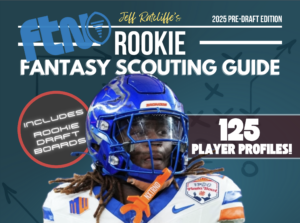
About a month ago, I got a message from our CEO, Kevin Adams:
“I have an idea for a new article. I want you to write it. It’s genius.”
And so, The Chalk Report was born. Essentially, this article will answer two questions as the season progresses — who is hitting and who is failing at each position? Last season, my Predicting NFL DFS Performance piece challenged a handful of industry assumptions:
- RBs are the most predictable because of their volume
- Pay up for stud RBs because their ceilings are incomparable
- Since WRs are more volatile, get contrarian there
- TEs are the most volatile and therefore the hardest to predict
No. 1 is wrong — WRs are more predictable and we’re better at identifying the best WR plays
No. 2 is wrong — once over $7k, price isn’t even predictive of performance. Plus, we often see popular stud RBs, but this is a position where we should be trying to diversify (except for value RBs)
No. 3 is wrong — it’s OK to diversify up top, but mid-tier WR chalk is the best chalk there is!
No. 4 is wrong — TEs are actually predictable, efficiently priced, and we as an industry are good at identifying the best plays.
Will this analysis hold throughout the 2022 regular season? There’s only one way to find out!
Defining the Chalk
D’Andre Swift was projected for 13.5% rostership, and Austin Ekeler was projected for 7.4%. Come Sunday, Swift was in 8.5% of lineups in the $27 100k Blindside while Ekeler was steamed up to 15.05%. Should either player be considered chalk? To answer, let’s consider why we seek to define chalk in the first place.
The entire point of this analysis is to help us make decisions about our lineups. Consequently, the best measure of rostership we’ll have when making key lineup decisions is the rostership projections. The projection has to matter. However, the actual roster percentage also informs our analysis because it tells us about how people actually felt about a play. For example, Ekeler’s increased rostership tells us that people felt he was in a better spot than his projections indicated. Consequently, for a player to be defined as chalk, he must project as such AND be rostered as such.
Further, the actual numbers themselves won’t matter as much when defining who is or isn’t chalk as the ownership of the player relative to other players at that position in that given week.
The Chalk Report
Quarterback
Only Jalen Hurts and Patrick Mahomes qualified as chalk at the QB position and both hit, especially Mahomes. Hurts’ separation from the field in popularity qualifies him as mega chalk.
Chalk: 2 hits, 0 misses
Mega Chalk: 1 hit, 0 misses
Running Back
Since Najee Harris, D’Andre Swift and Jonathan Taylor fell under 10%, only Christian McCaffrey, Saquon Barkley, Aaron Jones and Joe Mixon qualify as chalk. McCaffrey and Barkley were mega chalk.
Chalk: 2 hits, 2 misses
Mega Chalk: 1 hit, 1 miss
Wide Receiver
The five pictured WRs were chalk, with Michael Pittman and Marquise Brown qualifying as mega chalk. For their prices, Brown, JuJu Smith-Schuster and even Romeo Doubs were serviceable, so I’ll categorize them as neither hits or misses.
Chalk: 2 hits, 0 misses
Mega Chalk: 1 hit, 0 misses
Tight End
Travis Kelce and Dallas Goedert qualify as chalk, with Kelce as the clear mega chalk.
Chalk: 1 hit, 0 misses
Mega Chalk: 1 hit, 0 misses
Defense/Special Teams
This was a classic case of the “sneaky pivot” becoming the chalkiest of all, with Miami edging out Washington despite the field’s preference for Washington in many cash games. I’ll also call Chicago chalk since the weather made them a clear option. In fact, their sudden viability was clearly going to take some of the Washington ownership, removing the Commanders from mega chalk status.
Chalk: 2 hits, 1 miss
Mega Chalk: none
The analysis doesn’t stop here. The next question is where are the top scorers coming from at each position? Can the cheapest options compete from a ceiling perspective? What about the super contrarian options? Let’s find out.
Top Scorers
Quarterback
The top-scoring QBs have a little bit of everything. For the most part, expensive QBs with at least moderate popularity make up the top of the leaderboard. However, Carson Wentz is a glaring outlier in ownership, while both he and Jameis Winston are price outliers.
Running Back
A picture is worth a thousand words. The one above tells us two things, starting with the fact that we shouldn’t be surprised when cheap, or at least mid-tier RBs compete from a ceiling perspective with the most expensive of them all. Second, and perhaps more importantly, extremely contrarian RBs can deliver. In hindsight, we should have been all over Cordarrelle Patterson the moment Tyler Allgeier was declared inactive.
Wide Receiver
I once again love the story this picture tells us. First of all, Davante Adams, Ja’Marr Chase and A.J. Brown were all contrarian enough to be GPP winners. However, notice that they were all around 10% rostered and $5,500 or above. In line with last year’s findings, we should restrict our focus to the best WRs in football — WR is not a position to overthink.
Tight End
I included a handful of other TEs to show just how dominant Travis Kelce was Sunday. The key finding at the TE position last year was that we should always prioritize expensive TE chalk. As much as I loved Darren Waller this weekend, choosing Waller over Kelce was a mistake. As I like to say, we have to be right about who we don’t play just as much as we have to be right about who we do play. Waller could have crushed, and it wouldn’t have helped us separate from the field since Kelce was predictably awesome.
Defense/Special Teams
In a word? Chaos. There is no signal from either price or rostership in the DST top scorers of Week 1.
One Final Thought
There are two reasons why a rostership projection can be inaccurate. First, we could just be flat out wrong about how the public feels about a certain player. However, the second reason is that the projection itself can influence people’s willingness to use a player. Consequently, while the difference between actual rostership and projected rostership (delta) can simply be an error in projections, on the whole, it also tells us who “got steamed.”
In one of my GPP reviews last season, I hypothesized exactly what is shown above — the players who got steamed underperformed while the players the field initially loved, but eventually came off of to some degree, had great success. Why might this be the case? Simply put, it seems as though we overthink things and get too cute on Sunday mornings. It also could mean we overreact to the most recent news. For example, Aaron Jones went from a sub-10% expectation to one of the chalkiest plays on the slate because Allen Lazard was ruled out. Was Lazard that important for Jones’ outlook? Almost certainly not. The actionable info here is twofold:
- If you can predict who will get steamed, you know who to avoid (imagine if you pivoted off of Aaron Jones to AJ Dillon for the correlated leverage once Jones began getting steamed).
- Control your reaction to new information and trust the public’s initial thoughts on players (as well as your own).
Where This Article Goes from Here & Single-Entry Lineup Guidelines
First and foremost, I’ll be tracking the hit rate and miss rate for each position’s chalk throughout the season. Additionally, I’ll continue to investigate where the top scorers are coming from and how that should inform our decisions for where in our lineups we want to get the most contrarian.
Lastly, I’ll continue to monitor how “delta” predicts fantasy success. Do we continue to see this pattern of overreaction to late information and failure from steamed players?
When building my Week 2 Single-Entry lineup, I aim to follow these guidelines:
- Prioritize mid-tier WR chalk
- Every WR used should be a great WR (no unnecessary risks at the position)
- Prioritize expensive TE chalk
- The QB should be at least moderately rostered
- If a player you’re counting on to be contrarian gets steamed, pivot












































 New York Jets
New York Jets  New England Patriots
New England Patriots  Miami Dolphins
Miami Dolphins  Buffalo Bills
Buffalo Bills  Pittsburgh Steelers
Pittsburgh Steelers  Cleveland Browns
Cleveland Browns  Cincinnati Bengals
Cincinnati Bengals  Baltimore Ravens
Baltimore Ravens  Tennessee Titans
Tennessee Titans  Jacksonville Jaguars
Jacksonville Jaguars  Indianapolis Colts
Indianapolis Colts  Houston Texans
Houston Texans  Las Vegas Raiders
Las Vegas Raiders  Los Angeles Chargers
Los Angeles Chargers  Kansas City Chiefs
Kansas City Chiefs  Denver Broncos
Denver Broncos  Washington Commanders
Washington Commanders  Philadelphia Eagles
Philadelphia Eagles  New York Giants
New York Giants  Dallas Cowboys
Dallas Cowboys  Minnesota Vikings
Minnesota Vikings  Green Bay Packers
Green Bay Packers  Detroit Lions
Detroit Lions  Chicago Bears
Chicago Bears  Tampa Bay Buccaneers
Tampa Bay Buccaneers  New Orleans Saints
New Orleans Saints  Carolina Panthers
Carolina Panthers  Atlanta Falcons
Atlanta Falcons  San Francisco 49ers
San Francisco 49ers  Seattle Seahawks
Seattle Seahawks  Los Angeles Rams
Los Angeles Rams  Arizona Cardinals
Arizona Cardinals 








 Boston Celtics
Boston Celtics  Brooklyn Nets
Brooklyn Nets  Philadelphia 76ers
Philadelphia 76ers  New York Knicks
New York Knicks  Toronto Raptors
Toronto Raptors  Chicago Bulls
Chicago Bulls  Detroit Pistons
Detroit Pistons  Milwaukee Bucks
Milwaukee Bucks  Cleveland Cavaliers
Cleveland Cavaliers  Indiana Pacers
Indiana Pacers  Orlando Magic
Orlando Magic  Atlanta Hawks
Atlanta Hawks  Charlotte Hornets
Charlotte Hornets  Miami Heat
Miami Heat  Washington Wizards
Washington Wizards  Denver Nuggets
Denver Nuggets  Minnesota Timberwolves
Minnesota Timberwolves  Oklahoma City Thunder
Oklahoma City Thunder  Portland Trail Blazers
Portland Trail Blazers  Utah Jazz
Utah Jazz  LA Clippers
LA Clippers  Golden State Warriors
Golden State Warriors  Los Angeles Lakers
Los Angeles Lakers  Phoenix Suns
Phoenix Suns  Sacramento Kings
Sacramento Kings  Dallas Mavericks
Dallas Mavericks  Houston Rockets
Houston Rockets  Memphis Grizzlies
Memphis Grizzlies  New Orleans Pelicans
New Orleans Pelicans  San Antonio Spurs
San Antonio Spurs 










